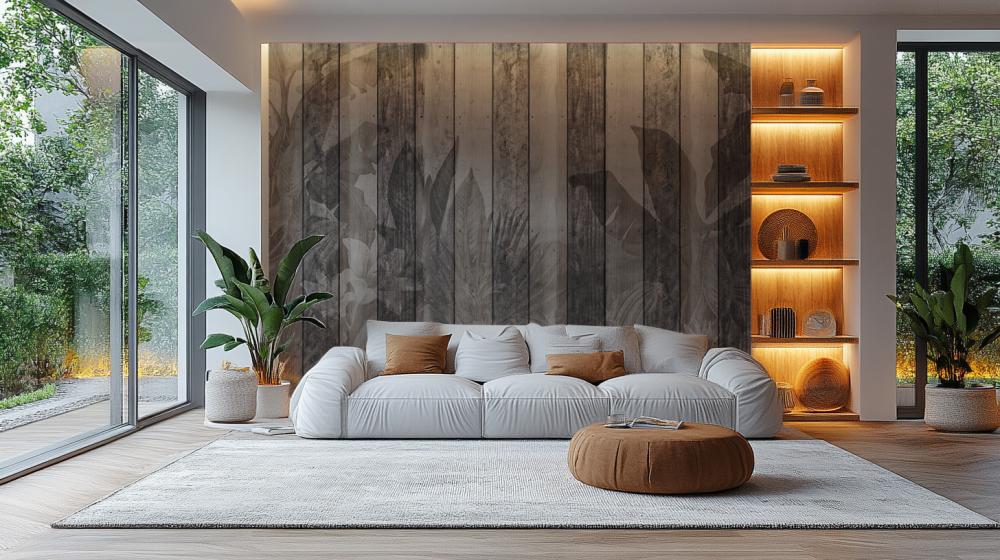Notifications

6 minutes, 24 seconds
-18 Views 0 Comments 0 Likes 0 Reviews

Textured wallpaper is a design secret that can completely redefine a room’s feel. While flat wallpaper is known for its color and pattern variety, textured styles bring a whole new layer of richness and sophistication. Whether you're styling a statement wall or rethinking an entire room, the right texture can set the tone and elevate your overall aesthetic.
Explore these creative wallpaper ideas to discover a wallpaper and style that matches your vision.
Grasscloth is a classic option made from natural fibers like jute, sisal, and hemp. Each roll is unique because the fibers are handwoven, resulting in a rich, organic texture. Grasscloth adds a subtle, earthy elegance to spaces and works especially well in dining rooms, studies, or accent walls.
Style Tip: Pair grasscloth with wooden furniture and warm lighting for a cozy, nature-inspired atmosphere.
Faux brick and stone wallpapers give your walls a raw, industrial edge—without the cost and hassle of real masonry. These are great choices for loft-style apartments or for creating an urban look in living rooms and kitchens.
Trending wallpaper alert: Faux brick is making a comeback in the latest wallpaper collections, especially in rustic and modern farmhouse interiors.
3D textured wallpapers use raised patterns to create a sense of depth and movement. These designs are ideal for modern homes that favor bold, artistic statements.
Creative wallpaper idea: Use 3D wallpaper on just one wall and keep the others minimal to avoid visual overload. This technique works particularly well in bedrooms and entryways.
For a luxurious look, fabric or velvet wallpapers can make a room feel like a high-end hotel. These materials add softness and warmth, making them perfect for bedrooms or formal sitting rooms.
Wallpaper trends note: Velvet wallpapers in deep jewel tones like emerald green, navy blue, and burgundy are part of the latest wallpaper design movements.
Want your walls to shimmer? Metallic and foil wallpapers reflect light beautifully and are often used to bring glamour and sophistication to a room. They're especially effective in small spaces where light reflection can make the room feel bigger.
Wallpaper and style tip: Combine metallic wallpaper with minimalist decor to keep the space from feeling too “busy.”
Cork is not just for bulletin boards anymore! As a wallpaper material, cork brings natural texture, sound absorption, and sustainability. It’s ideal for home offices or music rooms.
Creative wallpaper use: Try cork on one wall to double as a functional pin-up space for notes and ideas.
Wood veneer wallpaper mimics real wood paneling without the weight and installation cost. This style adds warmth and character to any room, especially when used in reading nooks or behind a bed frame.
Trending wallpaper style: Horizontal wood patterns can visually widen a small room, while vertical ones can make ceilings feel taller.
For a traditional yet stylish look, embossed damask or floral textures offer timeless elegance. These wallpapers often come in monochromatic tones and use raised surfaces to add dimension.
Latest wallpaper trend: Soft metallics and pearlescent finishes are being used to modernize these classic patterns.
Q: Is textured wallpaper hard to install?
A: It depends on the type. Some textured wallpapers, like peel-and-stick or faux brick panels, are easier to handle. Others, like grasscloth or fabric wallpaper, may require professional installation for best results.
Q: Can I paint over textured wallpaper?
A: Yes, in many cases you can paint over textured wallpaper, especially if it's in good condition. Just be sure to use a primer first and test a small area.
Q: Is textured wallpaper durable?
A: Textured wallpapers vary in durability. Vinyl-based options are generally more durable and easy to clean, making them good for high-traffic areas like hallways and kitchens.
Q: How do I clean textured wallpaper?
A: Use a soft brush or a damp cloth for light cleaning. Avoid harsh chemicals, especially on natural materials like grasscloth or cork.
Q: Where should I avoid using textured wallpaper?
A: Avoid using certain types of textured wallpaper (like fabric or velvet) in humid areas like bathrooms, unless they’re specifically designed for moisture resistance.
Textured wallpapers are an exciting way to add depth, warmth, and personality to your home. From the rustic charm of faux brick to the opulence of velvet and metallic finishes, there's a trending wallpaper out there to suit every taste.
